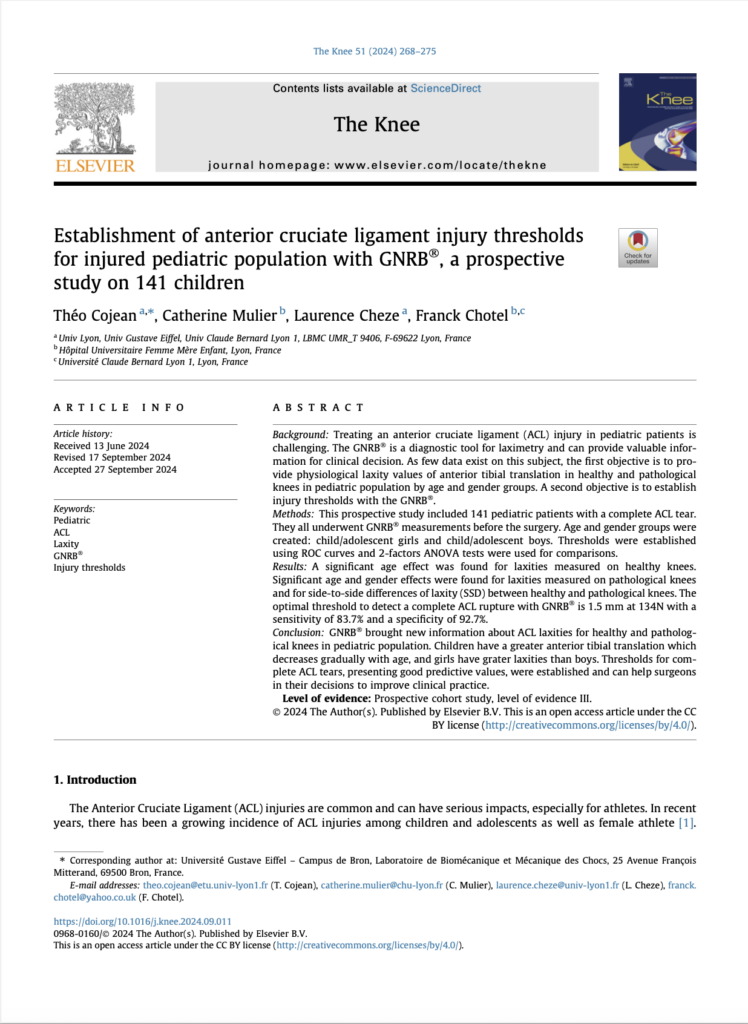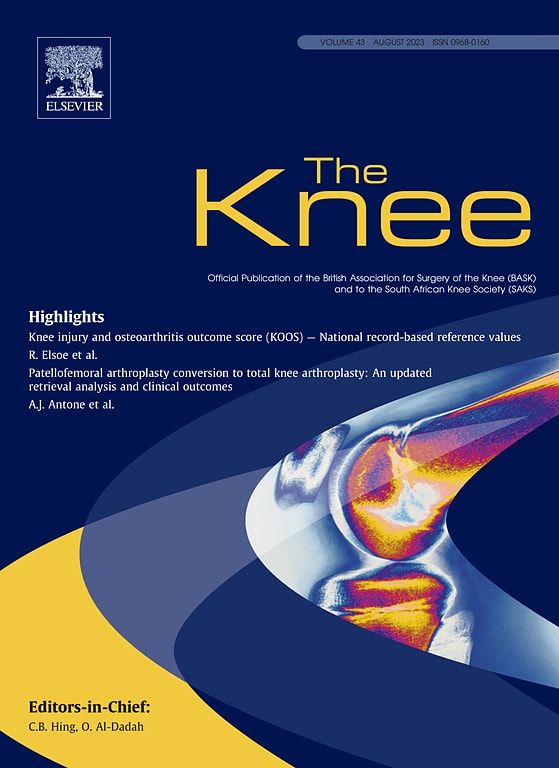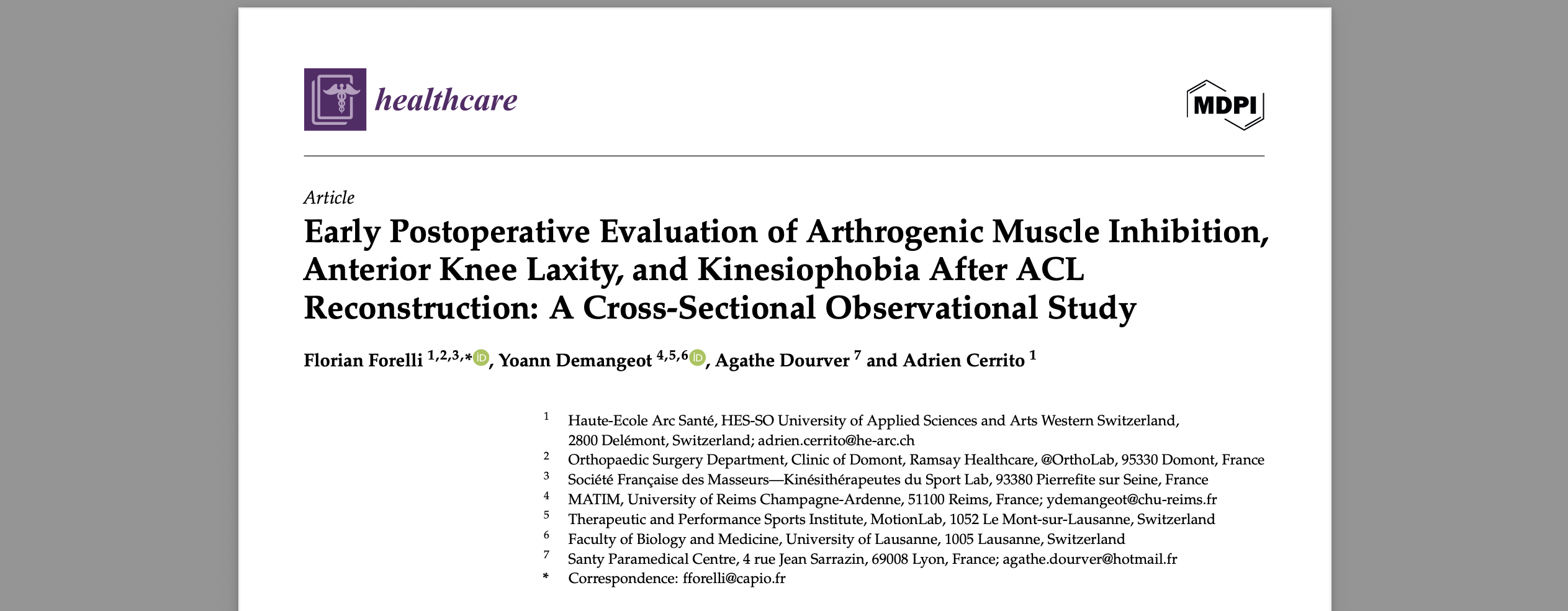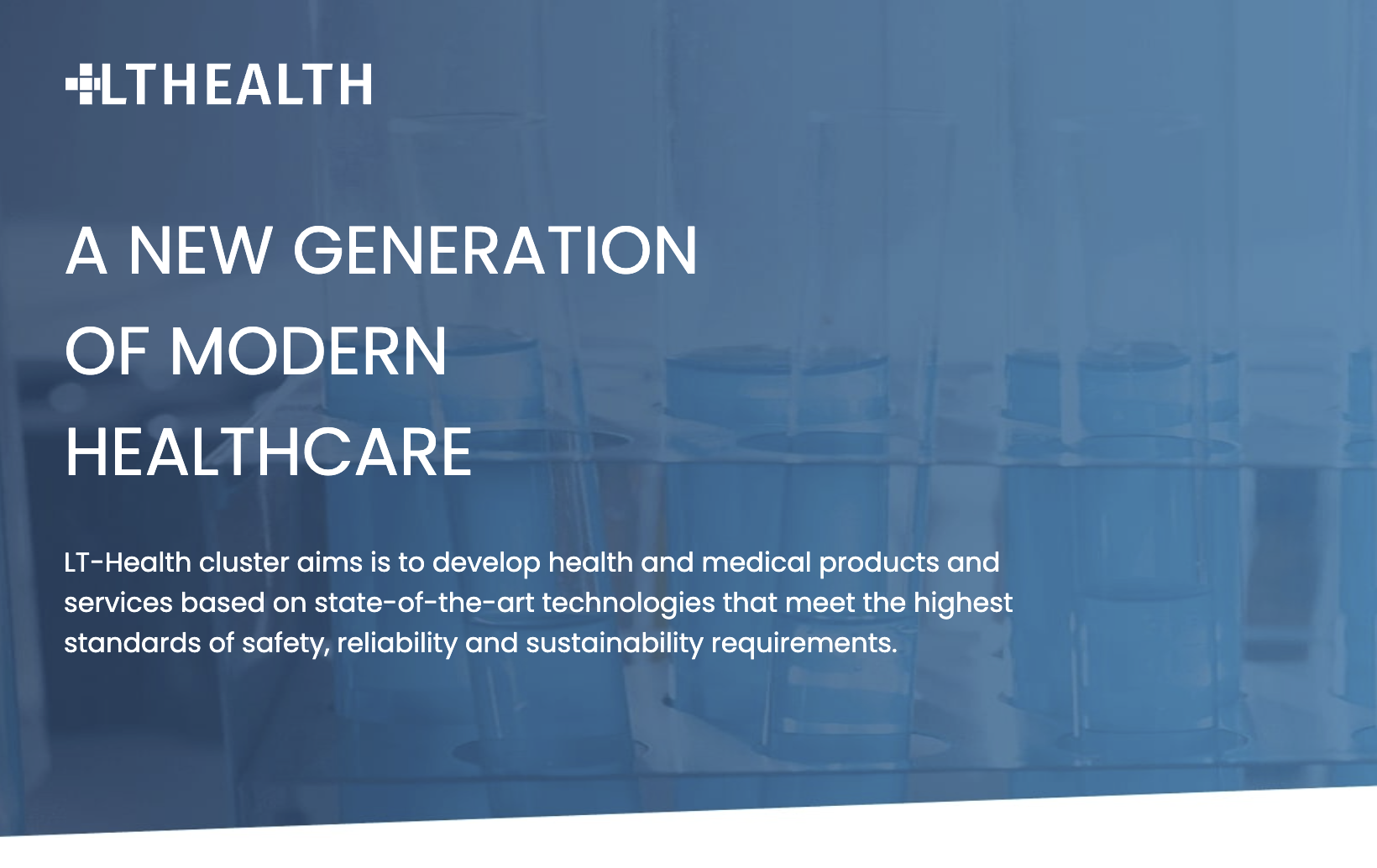Study title: Establishment of Anterior Cruciate Ligament Injury Thresholds for Injured Pediatric Population with GNRB®, a Prospective Study on 141 Children (Pediatric ACL Injuries).
DOI: 10.1016/j.knee.2024.09.011
Authors: Théo Cojean, Catherine Mulier, Laurence Cheze, Franck Chotel
Affiliations: Université Gustave Eiffel – Campus de Bron, Hôpital Universitaire Femme Mère Enfant, Université Claude Bernard Lyon 1, Lyon, France
Introduction: Understanding ACL Injuries in Children
Pediatric ACL Injuries are increasingly common among active children and adolescents, yet diagnosing these injuries is uniquely challenging. Traditional diagnostic tools, such as MRI, often miss subtle ligament laxities in children, whose bodies are still developing, making precise thresholds essential. This new study, “Establishment of Anterior Cruciate Ligament Injury Thresholds for Injured Pediatric Population with GNRB®: A Prospective Study on 141 Children”, introduces data-backed thresholds for assessing ACL injuries in pediatric patients using the GNRB® robotic arthrometer.
Authored by Théo Cojean and published in The Knee journal, this study is the first to establish ACL injury thresholds specifically for children and adolescents, with distinctions by age and gender. Below, we dive into the study’s methodology, key findings, and its impact on pediatric orthopedic care.
Study Background and Purpose
Diagnosing ACL injuries in children is challenging due to age-related physiological differences in knee laxity. Pediatric patients naturally exhibit greater knee laxity than adults, and this varies by age and gender. While MRI is valuable, it’s often insufficient for measuring the precise laxity needed for ACL diagnostics in young patients. The GNRB® arthrometer measures anterior tibial translation accurately, providing critical insights into knee stability.
The study aimed to establish reliable, pediatric-specific ACL injury thresholds. By examining knee laxity across 141 pediatric patients (ages 8 to 17), grouped by age and gender, the study identified key diagnostic markers for ACL injuries. These thresholds support clinicians in making more accurate diagnoses and better-informed decisions, especially when conservative treatment may be preferred.
Study Design and Methodology
The research was a prospective cohort study involving 141 children with complete ACL tears. All participants underwent detailed GNRB® measurements to capture knee laxity at different force levels. Key aspects of the methodology include:
Patient Cohort: The study included children aged 8–17 with ACL tears, awaiting arthroscopy. Grouping by age (8–13 for children, 14–17 for adolescents) and gender allowed for a detailed examination of knee laxity by demographic.
GNRB® Measurements: The GNRB® device was used to measure anterior tibial translation at forces of 67N, 89N, 134N, 150N, and 200N. This allowed precise recording of translation values that correlate with ACL stability.
Threshold Determination: Researchers conducted statistical analyses using Receiver Operating Characteristic (ROC) curves to determine the sensitivity and specificity of different laxity levels, identifying the optimal injury threshold for pediatric ACL tears.

The GNRB® uses a patented clamping system to hold the knee securely in place, measuring side-to-side differences (SSD) between injured and healthy knees. These measurements were analyzed with two-way ANOVA tests to ensure observed differences were statistically significant.
Key Findings: Establishing Pediatric-Specific ACL Injury Thresholds
The study’s findings represent a new level of diagnostic precision in pediatric ACL management. Here are some highlights:
1.5 mm Threshold at 134N Force: The study identified a 1.5 mm anterior tibial translation threshold at 134N as optimal for detecting ACL ruptures, with 83.7% sensitivity and 92.7% specificity. This high accuracy minimizes false positives or negatives, offering a benchmark that clinicians can confidently use in pediatric ACL assessments.
Influence of Age and Gender: Results showed that children (8–13) have greater knee laxity than adolescents (14–17), while girls exhibited higher laxity than boys, particularly in injured knees. These findings reinforce the importance of age- and gender-specific thresholds for diagnosing ACL injuries in children.
Reliability of GNRB®: The GNRB® device outperformed other laximetry tools by providing consistent, reproducible measurements essential for pediatric diagnostics. This allows clinicians to obtain quantitative data that complements MRI findings and is especially useful when MRI alone may not capture subtle laxity changes.
Detailed Analysis of GNRB® Measurements
To achieve accurate thresholds, the study focused on side-to-side differences (SSD) between the injured and healthy knees. These values are critical in understanding the impact of ACL tears on knee stability. Specific findings included:
- SSD at 67N, 89N, and 134N: SSD values peaked at 134N, making this force level the most effective for identifying ACL ruptures. Lower forces were also tested but didn’t show the same diagnostic accuracy.
- Compliance Measurements: Compliance, which reflects knee flexibility, was also measured and revealed higher compliance in children. However, compliance alone was not considered a reliable metric, but it supported the laxity data.
These measurements create a comprehensive profile of knee stability in young patients, aiding in evidence-based treatment decisions.
Significance of This Study for Pediatric Orthopedic Care
The implications of this study are profound for clinicians, especially those working with young athletes. Here’s why these findings are so valuable:
Age- and Gender-Specific Diagnostics: By establishing pediatric-specific thresholds, clinicians gain tools for more accurate assessments. Tailored thresholds by age and gender optimize diagnostic precision for each child’s developmental stage.
Improved Diagnostic Reliability: The GNRB® provides objective data that enhances MRI scans, offering insights where subtle ACL injuries may go undetected on imaging alone.
Guided Treatment Decisions: These thresholds support evidence-based decision-making about treatment, helping surgeons distinguish between cases that require surgical intervention and those suitable for conservative management.
Supporting Conservative Care: Since surgery in children can carry risks, the GNRB® enables clinicians to monitor knee stability over time and only intervene if instability worsens.
Conclusion: The GNRB® as a Game-Changer in Pediatric ACL Injuries Diagnostics
This study provides essential, scientifically backed thresholds that help clinicians diagnose ACL injuries in children and adolescents with unmatched accuracy. With the GNRB® arthrometer, healthcare professionals have a tailored diagnostic tool that bridges the gap left by traditional methods.
Using age- and gender-specific thresholds, orthopedic surgeons and sports medicine specialists can make more confident decisions about diagnosing and treating ACL injuries in young patients. For those interested in the full findings, the study can be accessed in The Knee, Volume 51, Issue 2, pages 268–275 on Elsevier’s platform [link to study].
Note: Only a preview is available here; access to the full study is subject to publisher restrictions.
Medical References
- Cojean, T., Mulier, C., Cheze, L., & Chotel, F. (2024). Establishment of anterior cruciate ligament injury thresholds for injured pediatric population with GNRB®, a prospective study on 141 children. The Knee, 51(2), 268–275. DOI: 10.1016/j.knee.2024.09.011







